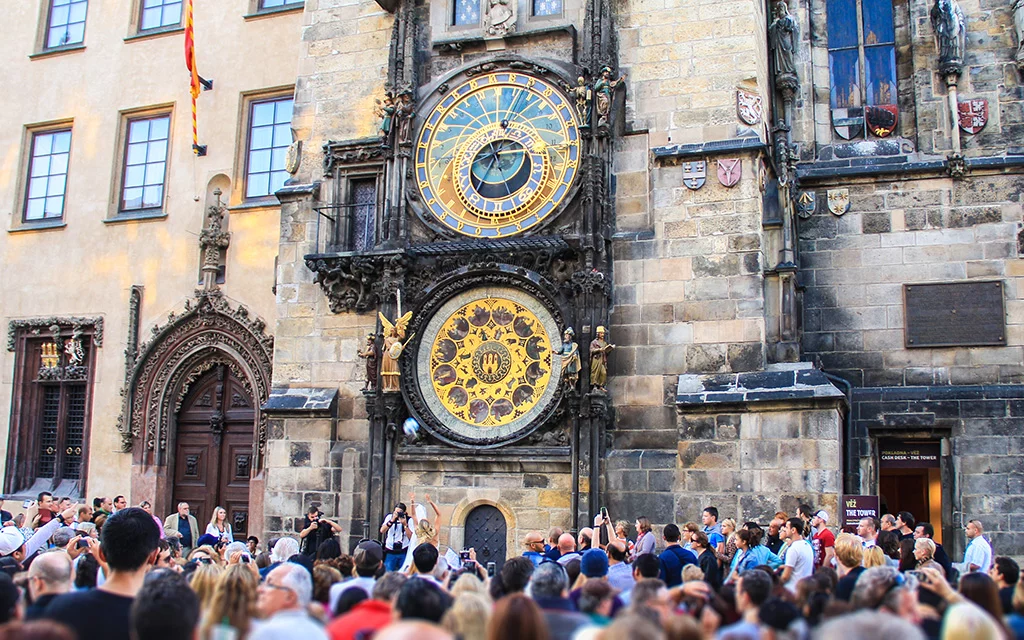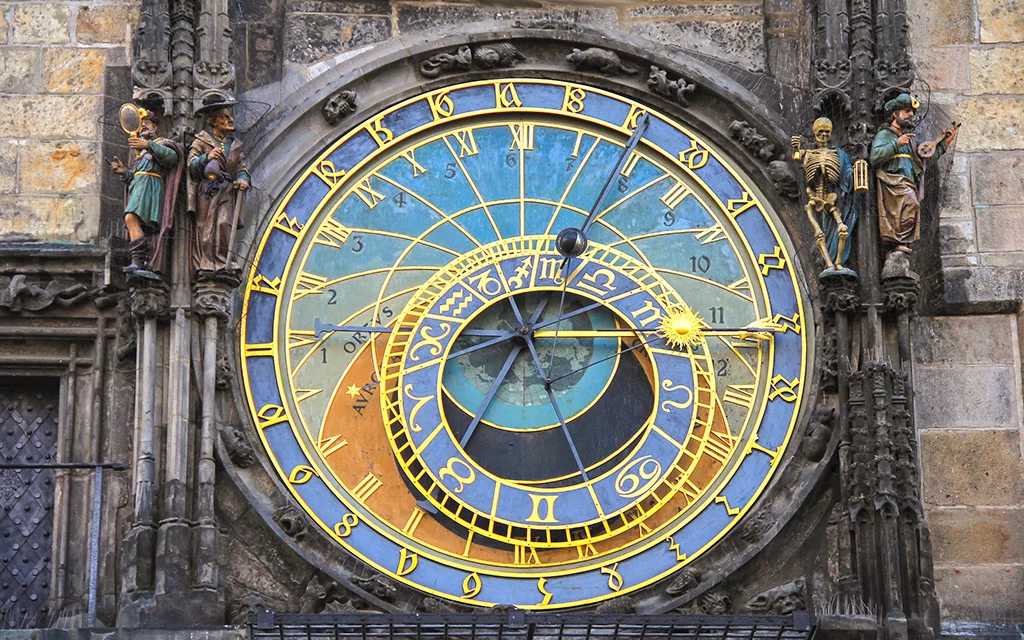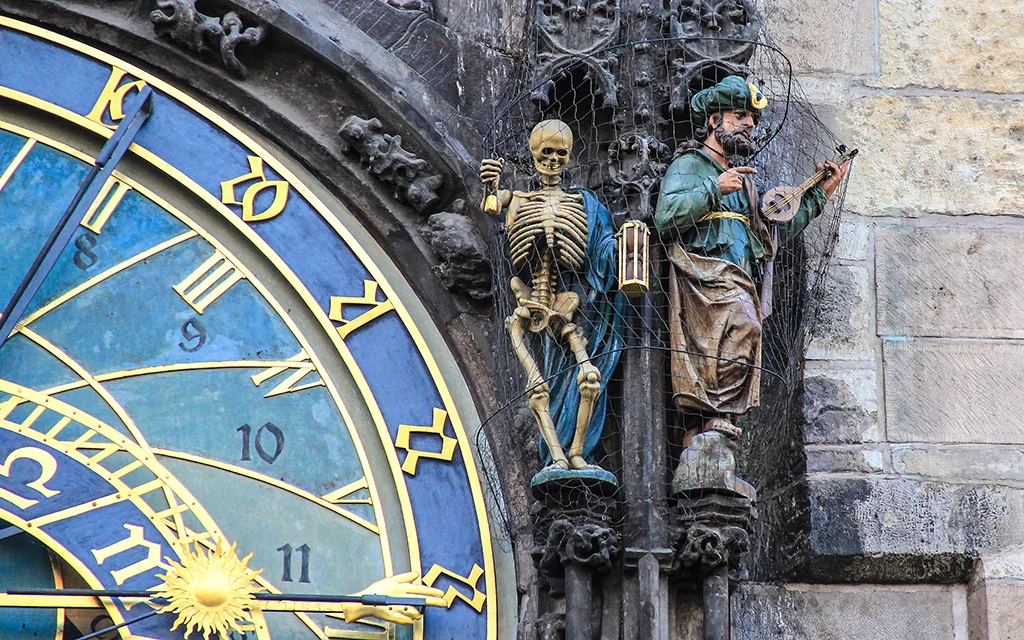Prague is a favorite city for Central European tours with its elegant bridges, cathedrals and unique architectural structures. Prague Astronomical Clock , whichthose who go to Prague do not return without seeing, is located in the Old Town Square in the heart of the city. When you come to the historical square of the impressive city on the Vltava River, you listen to the bell set of the Astronomical Clock and marvel at how such an old mechanism can still work. Built in 1410, it is the third oldest clock in the world and the oldest in working condition.
Throughout history, clocks have not only been used to define time, but have also been tools to determine the location of the moon and sun in the sky. The clock in Prague, one of the most beautiful cities in the world, also shows the position of the Moon and Sun around the world according to the current time zone. The original name of the Astronomical Clock, which carries the symbols of 12 zodiac signs along with 12 time zones, is Orloj .

Prague Astronomical Clock
The Astronomical Clock, one of the symbols of the city of Prague, which hosts more and more visitors every year, gives much more information than minutes and hours.
Thanks to the dial on the watch, it is an enormous structure that makes it possible to read astronomical information about where the sun, moon, constellations and planets are located in the sky. The clock consists of four main parts.
- Astronomical Dial
- 'The Walk of the Apostles' Clock Animation
- Zodiac Ring
- Calendar Dial
According to the belief in the Czech Republic, if the clock stops one day, it indicates that the whole country will be plunged into disaster. Perhaps for this reason, sensitivity is shown to prevent the watch from malfunctioning. The numbers on the outside of the watch are in Hebrew and indicate this Babylonian time. The upper part of the watch shows the months, while the lower part shows the time. The blue part of the watch represents the infinity of the sky and the brown part represents the earth.
Prague Astronomical Clock Story

1. Astronomical Dial
This part of the clock is a mechanical construction used in medieval astronomy. The background consists of red and black colors that symbolize the earth and sky. In this area, which is divided into a 24-hour time zone with Roman numerals, it is also possible to see the sunrise and sunset times that change continuously throughout the year.
2. 'The Walk of the Apostles' Clock Animation
At the beginning of every hour, many people gather under the Astronomical Clock to watch the movement of the four figures on the clock. Each of the figures has different meanings.
- The figure looking in the mirror: smugness
- Skeleton: Death
- Figure holding a gold pouch: Greed
- Ottoman Figure: Fun
The figure looking at the mirror in his hand, arrogance and self-conceit; a miserly Jewish figure holding a purse symbolizes greed. Figure II with a mirror. It was placed after World War II. The mobile system was badly damaged in the fire that broke out before.
While the skeleton figure on the right side of the clock symbolizes death; The Ottoman figure playing the mandolin symbolizes pleasure, fun and pleasure. The death figure is the oldest part of the clock since the late 15th century. In addition to these figures, there are Twelve Apostles on the clock.

In the hourly animation, the skeleton figure signals that it's time to die, and all the figures shake their heads, expressing that they are not ready for death. First, the figure holding an hourglass in one hand looks at the clock of death and pulls the rope of the death knell with the other hand. Thereupon, wooden windows open, behind which Jesus and his 12 apostles pass. The windows close and a rooster crowing is heard.
The figures on the left at the top clock are by Vojtěch Sucharda; He has a statue of Archangel Michael with shield and spear in his hand. On the right, we see a Prague astronomer with binoculars and a historian holding a book.
3. Zodiac Ring
From the zodiac symbols in the second ring inside the black outer ring, it can be understood where the sun is located in the sky at that moment.
600 years of Astronomical Clock
There are many rumors about the construction of the Astronomical Clock. The most widely accepted of these is that it was made by the clockmaker Hanus in the 15th century and he was blinded by the traditional blinding method, which was widely practiced at that time, so that he could not produce a work of such beauty.
However, Hanus took revenge for this injustice done to him by breaking the mechanism of the clock. The clock, which did not work for years until it was repaired by another great master, has survived many times by breaking down and repairing it. The watch, which last underwent a comprehensive repair in 1865, received serious blows again by the Germans in World War II.
Two geniuses joined forces to build the clock that has survived to this day and attracts millions of tourists every year; watchmaker Mikulas Kadan and Charles University mathematics professor Jan Sindel. Gothic statues and a calendar dial were added to the clock in 1490, and figures of the apostles were added in 1787.
The clock, which was damaged in the Prague Uprising in 1945, was restored in 1948 and became operational. On October 9, 2010, a big celebration was held for the 600th anniversary of the Astronomical Clock. The making of the watch, the damages it suffered, its mechanism and important events that took place during the years that the watch was in existence were exhibited through videos through the lights reflected on the watch.
From the Astronomical Clock Tower, which is a prismatic tower, besides the view of the Old Town Square, a magnificent view of Prague is also observed. The tower, which is exactly 69.5 meters high, is reached by two elevators. The first elevator goes up to the third floor, from here you can take the steep stairs or you can use the second elevator.
There are many opinions among travelers regarding the Astronomical Clock. Some state that it should be considered as a work of art made 600 years ago and must be visited, while others think it is a trap to attract tourists to the city. Despite everything, it is one of the rare works that deserves to be visited by many travel lovers.
Tower visiting days and hours : Between November and March, 11:
00-17:00 on Mondays Tuesday, Wednesday, Thursday, Friday, Saturday and Sunday 09.00-17.00
April-October 11:00-18.00 on Mondays
Tuesday, Wednesday, Thursday, Friday, Saturday and Sunday 09.00-18.00
Tower entrance fee : 110 CZK full ticket, 70 CZK discounted ticket.
The 9th century historical place of Prague is the huge Prague Castle, the heart of the city is the Old Town Square (Staromestske nam), the most interesting places are Charles Bridge, Old Town Bridge Tower (Stare Mesto) and St. Nicholas Church is on the list of places to visit in Prague .
The fact that the Astronomical Clock, which is an engineering miracle, has survived until today and works without any interruption, reveals its importance. Turn your route to Prague to see the unique clock in the world and embark on a 600-year-old historical journey.
Prague is an amazing city. It can be visited on a very nice 1-week route with Budapest and Vienna . Prague Ruzyne airport's triple code is "PRG", its distance from the city center is approximately 20 km. The flight time from Istanbul to Prague takes approximately 2 hours and 50 minutes.
